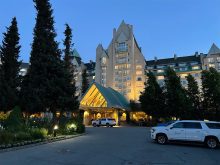The adage “you are what you eat” knows no boundaries, be it in the
plant or animal kingdom.
Centuries of biology and physiology have created a specific appetite
for each living thing.
The science of this is called “nutrition.” Science has figuratively and
literally “boxed and bagged” nutrition into nutritionally complete
feeds.
But it might be time to pull back on the reins before this becomes a
runaway.
The basis of a horse’s diet can be found in a healthy pasture: green
Read Also

Downturn in grain farm economics threatens to be long term
We might look back at this fall as the turning point in grain farm economics — the point where making money became really difficult.
grass, hay and other assorted green plants. More nutrition will not
make a horse perform beyond its potential.
Building the strong framework of a horse begins at conception and
ideally before that as the mare prepares to receive the embryo.
The brain, nervous systems and cartilaginous skeleton are formed early
in pregnancy. These systems are the physical framework and its wiring,
so proper nutrition is needed throughout pregnancy.
The growing embryo harvests macro and microminerals during pregnancy.
Upon birth, a storehouse of minerals exists in the foal for balanced
bone growth.
Nutritional balance is important to providing a full spectrum of
building blocks. Nutritional imbalances, as opposed to nutritional
deficiencies, tend to arise when we look to artificial means to meet
the demands of a healthy growing animal.
It is like building a house. You gather the necessary building
materials such as wood, nails, cement, paint and shingles. But if you
are short on nails, the structure’s integrity is sure to be flawed.
More wood, cement, or paint will not correct the problem.
Balance among minerals is the key to optimum mineral levels in the
body.
Also important is a mineral’s bioavailability, which means the horse
can use the form of mineral that is given.
For example, nails might be made with iron, but it’s pointless to put
them in the feed bucket because the horse can’t use that source of
iron. Yet it can become bioavailable by placing that nail in the soil,
where the iron is broken down and can be used and accumulated by plants
the horse eats.
Careful examination of the numerous interactions among, between and
because of various elements in food is a humbling experience. So I
shall default to the wisdom of nature and suggest horse owners ensure a
quality source of grasses, grass hays, and herbs and weeds for their
horses.
Maintaining healthy pastures and rotating pastures are invaluable to a
horse’s health. It will often have scattered growths of herbs and
weeds. Dandelions and thistles are but two that horses search out and
eat.
Tree bark is seldom considered part of a horse’s diet, yet when eaten
in small quantities it
provides numerous minerals and certain nutrients beneficial to
digestive tract health. Natural wear on teeth also helps maintain their
soundness – all within reason and balance.
Grain should be fed in moderation. Recent research has shown that
dramatic glucose and insulin spikes occur in horses after eating
carbohydrate-rich diets.
Large grain diets tend to trigger a rush of insulin followed by a blood
sugar crash, which causes stress on the glandular system.
It has also been found that high insulin levels suppress cartilage cell
maturity. Bone formation evolves out of a cartilaginous skeleton. A
faulty cartilaginous foundation sets the stage for developmental bone
diseases.
The philosophy of feeding large amounts of protein to young growing
horses and brood mares needs to be tempered with the philosophy that no
mammal is designed to have a protein level higher than is present in
its mother’s milk.
Excessive protein intakes are not benign.
















